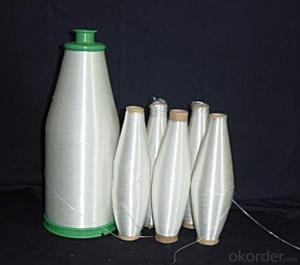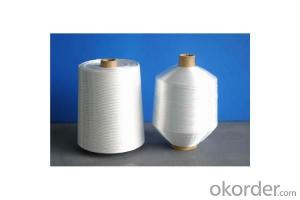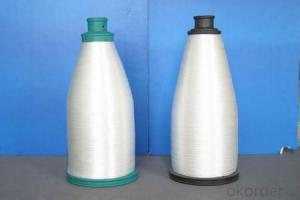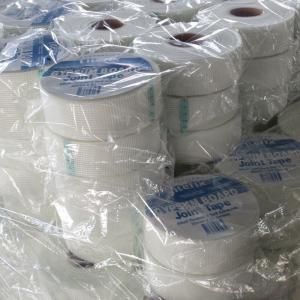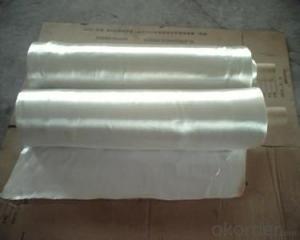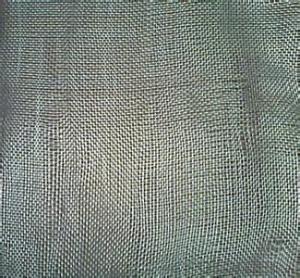C/E Fiber Glass Yarns with Best Price and Quality
- Loading Port:
- China Main Port
- Payment Terms:
- TT or LC
- Min Order Qty:
- 2000kg kg
- Supply Capability:
- -
OKorder Service Pledge
OKorder Financial Service
You Might Also Like
Description:
C or E textile glass a kind of additional twisting and plying yam. With the characteristics of high strength, corrosion resistance, heat resistance and high moisture absorption, no alkali yam has high electric insulation, so it used to produce weaved wires and cables’ wrap cladding, protection sleeve, train of mine, insulation materials of electric machinery, every yam of woven cloth and other industrial yam. It can also supply big and little paper cube and other cube yams with different shapes and different roll weight.
Product Features:
● Good Dispersibility.
● Less fuzzy.
● Density Even.
 Product Specifications:
Product Specifications:
Product Code | Tex | diameter (um) | Sizing. | breaking strength | Twist |
CC7.5-22-1/2 110S | 44 | 7.5 | paraffin | ≥15.5 | 110±10 |
EC9-33-1/2 65S | 66 | 9 | ≥24.1 | 65±5 | |
EC8-25-1/2 65S | 50 | 8 | ≥19.2 | 65±5 | |
CC9-33-1/2 65S | 33 | 9 | ≥20.6 | 65±5 | |
CC11-44-6/0 | 264 | 11 | ≥81.6 | ||
CC11-44-1/3 110S | 132 | 11 | silane | ≥40.8 | 28±3 |
EC9-68-1/0 28Z | 68 | 9 | ≥18.0 | 28±3 |
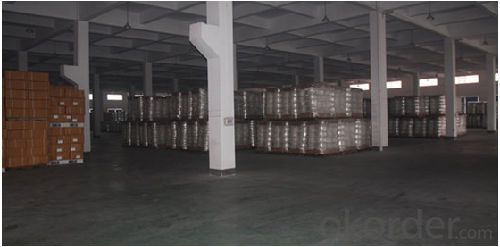
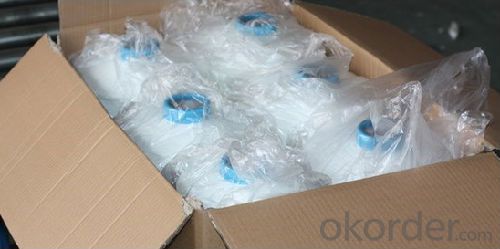
Storage:
Unless otherwise specified,It should be stored in a dry, cool and rain-proof area. It is recommended that the room temperature and humidity should be always maintained at 15℃~35℃ and 35%~65% respectively.
packaging:
with cartons
FAQ:
1.What is the delivery time ?
15days after receiving the deposit
2.Are you a trading company or factory.
We are factory,and we have more than 10 years of experience.
- Q:Can fiberglass fabric be used for insulation in industrial equipment?
- Fiberglass fabric proves to be a suitable option for insulating industrial equipment, given its various qualities. Its versatility and exceptional thermal insulation properties make it an ideal material. Not only is it lightweight, but it is also non-combustible and resistant to heat, chemicals, and moisture. These characteristics make it highly suitable for insulating industrial equipment including boilers, furnaces, tanks, and pipes. By effectively minimizing heat transfer, it successfully reduces energy loss and ensures stable temperatures during industrial processes. Moreover, its installation is effortless, it is highly durable, and it boasts a long lifespan, thereby making it a cost-effective solution for insulation in industrial applications.
- Q:What is the cost range for fiberglass fabrics?
- The cost range for fiberglass fabrics can vary depending on various factors such as the quality, weight, and width of the fabric, as well as the supplier and any additional features or treatments applied to the fabric. On average, fiberglass fabrics can range from around $5 to $20 per yard. However, higher-end or specialty fiberglass fabrics with specific properties or finishes can be priced higher, with some reaching up to $50 or more per yard. It is important to note that these prices are approximate and may vary based on market conditions and individual suppliers. Additionally, bulk orders or wholesale purchases may offer discounts, so it is recommended to contact suppliers directly for accurate pricing information.
- Q:Can fiberglass fabric be sewn?
- Indeed, sewing fiberglass fabric is indeed possible. Nevertheless, it is crucial to acknowledge that the task of sewing fiberglass fabric can be quite formidable due to its rigid and rough characteristics. It may necessitate the utilization of specialized sewing apparatus and methods, including heavy-duty needles and thread, as well as modifying the sewing machine settings to accommodate the fabric's peculiarities. Furthermore, it is advisable to don protective attire and ensure proper ventilation while handling fiberglass fabric, as the fibers can provoke skin irritation and respiratory problems if breathed in.
- Q:Can fiberglass fabric be used for insulation in mining operations?
- Fiberglass fabric has the capability to be utilized as insulation in mining operations. Its remarkable thermal insulation properties are widely recognized, rendering it a suitable choice for various applications, including mining operations. By effectively capturing and inhibiting the transfer of heat, it contributes to maintaining a consistent temperature within mining environments. Furthermore, the high temperature, corrosion, and chemical resistance of fiberglass fabric make it particularly well-suited for the frequently encountered harsh conditions in mining operations. Its lightweight and flexible characteristics also facilitate easy installation and handling in diverse mining structures and equipment. In summary, fiberglass fabric presents itself as a dependable and efficient solution for insulation in mining operations.
- Q:Can fiberglass fabric be used for insulation in telecommunications cables?
- Yes, fiberglass fabric can be used for insulation in telecommunications cables. Fiberglass fabric has excellent thermal insulation properties, making it an ideal choice for insulating cables that carry electrical signals. It can withstand high temperatures and is resistant to fire, chemicals, and abrasion, providing a reliable and durable insulation solution for telecommunications cables. Additionally, fiberglass fabric is lightweight, flexible, and easy to handle, making it convenient for cable installation and maintenance. Its high dielectric strength also ensures that it does not interfere with the electrical signals transmitted through the cables. Therefore, fiberglass fabric is commonly used as an insulation material in telecommunications cables to protect the cables and ensure efficient and reliable signal transmission.
- Q:Are fiberglass fabrics available in different colors or finishes?
- Fiberglass fabrics come in various colors and finishes, offering a wide range of options. While the natural color of fiberglass fabric is typically white or off-white, it can be transformed through dyeing or coating processes to achieve diverse colors and finishes. Dyeing involves using specialized colorants that penetrate and bond with the fibers, resulting in vibrant and eye-catching hues. These colored fiberglass fabrics find extensive use in applications where aesthetics play a vital role, such as the manufacturing of clothing, home decor items, and automotive interiors. Moreover, fiberglass fabrics can also be coated with different finishes like silicone, acrylic, or polyurethane, which not only enhance their performance but also provide specific properties like water resistance, heat resistance, or chemical resistance. The availability of a variety of colors and finishes in fiberglass fabrics opens up countless opportunities for both creative and functional applications.
- Q:Can fiberglass fabric be used for making signs and banners?
- Yes, fiberglass fabric can be used for making signs and banners. It is a durable and versatile material that can withstand outdoor conditions, making it suitable for various signage applications.
- Q:How long does fiberglass fabric typically last?
- Fiberglass fabric typically lasts for a long time, often up to 20 years or more, depending on various factors such as the quality of the fabric, maintenance, and environmental conditions.
- Q:Can fiberglass fabric be dyed?
- Certainly, dyeing fiberglass fabric is possible. This versatile material lends itself to a range of dyeing techniques, allowing for vibrant coloration. Nevertheless, it is crucial to understand that dyeing fiberglass fabric may deviate from conventional fabric dyeing practices. Given its synthetic composition, specialized dyes or specific dyeing methods may be necessary. To achieve optimal and enduring outcomes, it is advisable to refer to the manufacturer's guidelines or seek expert counsel when undertaking the dyeing of fiberglass fabric.
- Q:How is fiberglass fabric cleaned?
- To easily clean fiberglass fabric, you can follow some simple procedures. Begin by eliminating any loose dirt or debris from the fabric through vacuuming or gently brushing. For general cleaning, create a mixture of mild detergent and warm water. Proceed to gently scrub the fabric using a soft brush or sponge, ensuring that all areas are covered evenly. It is advised to avoid harsh chemicals or abrasive materials, as they could potentially harm the fabric. Once you have finished scrubbing, thoroughly rinse the fabric with clean water to eliminate any soap residue. Lastly, allow the fabric to completely air dry before using it again. By adhering to these steps, you will effectively maintain the cleanliness and durability of your fiberglass fabric.
1. Manufacturer Overview |
|
|---|---|
| Location | |
| Year Established | |
| Annual Output Value | |
| Main Markets | |
| Company Certifications | |
2. Manufacturer Certificates |
|
|---|---|
| a) Certification Name | |
| Range | |
| Reference | |
| Validity Period | |
3. Manufacturer Capability |
|
|---|---|
| a)Trade Capacity | |
| Nearest Port | |
| Export Percentage | |
| No.of Employees in Trade Department | |
| Language Spoken: | |
| b)Factory Information | |
| Factory Size: | |
| No. of Production Lines | |
| Contract Manufacturing | |
| Product Price Range | |
Send your message to us
C/E Fiber Glass Yarns with Best Price and Quality
- Loading Port:
- China Main Port
- Payment Terms:
- TT or LC
- Min Order Qty:
- 2000kg kg
- Supply Capability:
- -
OKorder Service Pledge
OKorder Financial Service
Similar products
New products
Hot products
Hot Searches
Related keywords

